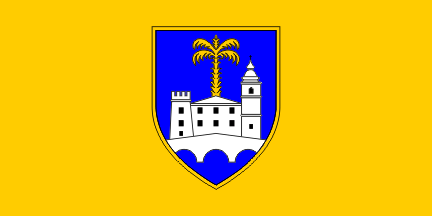
image by Željko Heimer

Last modified: 2010-02-19 by dov gutterman
Keywords: crikvenica | primorsko-goranska |
Links: FOTW homepage |
search |
disclaimer and copyright |
write us |
mirrors
See also:
Other Sites:
The coat of arms is blue with a house over a bridge with an
embattled tower to the right and a bell-tower to the left all
silver/white, from which is issuing a golden palm tree. The flag
is yellow with the coat of arms in the middle. Adopted: around
1995 (?).
Source: Flag for hoisting on streets of Crikvenica, 20x40
cm, 1997.
Željko Heimer
The decisions in the official gazette regarding the flag of
Crikvenica:
- Odluka o osnivanju Odbora za grb i zastavu, Službene
novine Županije primorsko-goranske, br. 2/95.
- Odluka o grbu i zastavi Grada Crikvenice, 03.08.1995,
Službene novine Županije primorsko-goranske, br. 12/96,
10. svibnja 1996.
- Odluka o uvjetima uporabe grba i zastave Grada Crikvenice,
03.08.1998, Službene novine Primorsko-goranske
županije, br. 17/98, 21. kolovoza 1998.
The first one establishes a commission to prepaire for the
adoption of the symbols.
The 1995 decision adopts the symbols (the buildings in the Coat
of Arms represent the old fortified city of Crikvenica, so called
'kaštel'). The decision prescribes that it shall be
published in the gazette after the ministry approves the design,
so the publication date only in May 1996 - presumably after the
approval from the Ministry, of course.
The third one further elaborates on conditions of use of the city
symbols and the procedure for their commercial exploitation. It
prescribe, like the most other decisions in Croatia, that the use
of the coat of arms and the flag in educational, scientific and
artistic purposes is free as long as it does not undermine the
dignity and fame of the city.
Here in Crikvenica also use in propaganda purposes the use is
free under above conditions, though I am not quite sure how could
they determine what propaganda is dignified and what is not. The
adoption date of the flag would be 3 August 1995.
The decisions do not mention the ceremonial flag even as a hint,
even if it is certainly used, as seen on photos in media.
Željko Heimer, 17 August 2003
The symbols were designed by the Heralid
Art d.o.o company in Rijeka.
Željko Heimer, 4 November 2007
The new 2009 repeats word for word determinations of the
previous 2001 Statutes Article 4 describing the coat of arms and
the flag (previous 1993 do not describe them.)
- Statut Grada Crikvenice, 11.10.2001, Službene novine
Primorsko-goranske županije, br. 26/2001, 26.10.2001
- Statut Grada Crikvenice, 14.07.2009, Službene novine
Primorsko-goranske županije, br. 26/2009, 15.07.2009.
Željko Heimer, 7 December 2009
ri-cc78.gif)
image by Željko Heimer, 9 December 2009
Before the adoption of the current symbols, Crikvenica adopted
its first "coat of arms" during the socialist period in
1978, designed by Pero Cimbur, a productive designer of numerous
city arms in the late Yugoslav period. The coat of arms (emblem)
is typical of the style of the period, remote from the
traditional heraldry: in a light blue shield a gray tower between
two white sails ensigned with a green tree above a gray bridge
with tree arches over a blue river and in base a brown ship
afrontee its top in chevron inverted edged green its oar holes
gules and in the chief a red five-pointed star. The ship's oar
holes forms letter C for Crikvenica, the bridge is that over the
Dubracina stream near which the Frankapan's tower was erected in
15th century. It is set between two "sails"
representing the two other towns at the time being parts of the
community (larger territorially then the current city), Novi
Vinodolski and Selca and the trees represent the forest laying in
the hinterland.
The flag was not adopted.
The process of designing of the coat of arms is described vividly
by the author in his book Pero Cimbur: Natjecanje za grb,
Školska knjiga, Zagreb, 1985.
I do not think that it is a coincidence that the current coat of
arms is somewhat reflecting the previous one. The new coat of
arms also shows the Frankapan tower, withing the complex of the
Crikvenica castle - the Pauline monasterly established by
Frankapans in 1412. The monastery and church (which provided the
name for Crikvenica - developed from 'cr(i)kva' - church) were
obviously not chosen to be shown in the socialist period for
reasons of ideology. Again, the ideological red star was removed
from the modern coat of arms. However, when one considers all the
two coats of arms are much related.
Željko Heimer, 9 December 2009